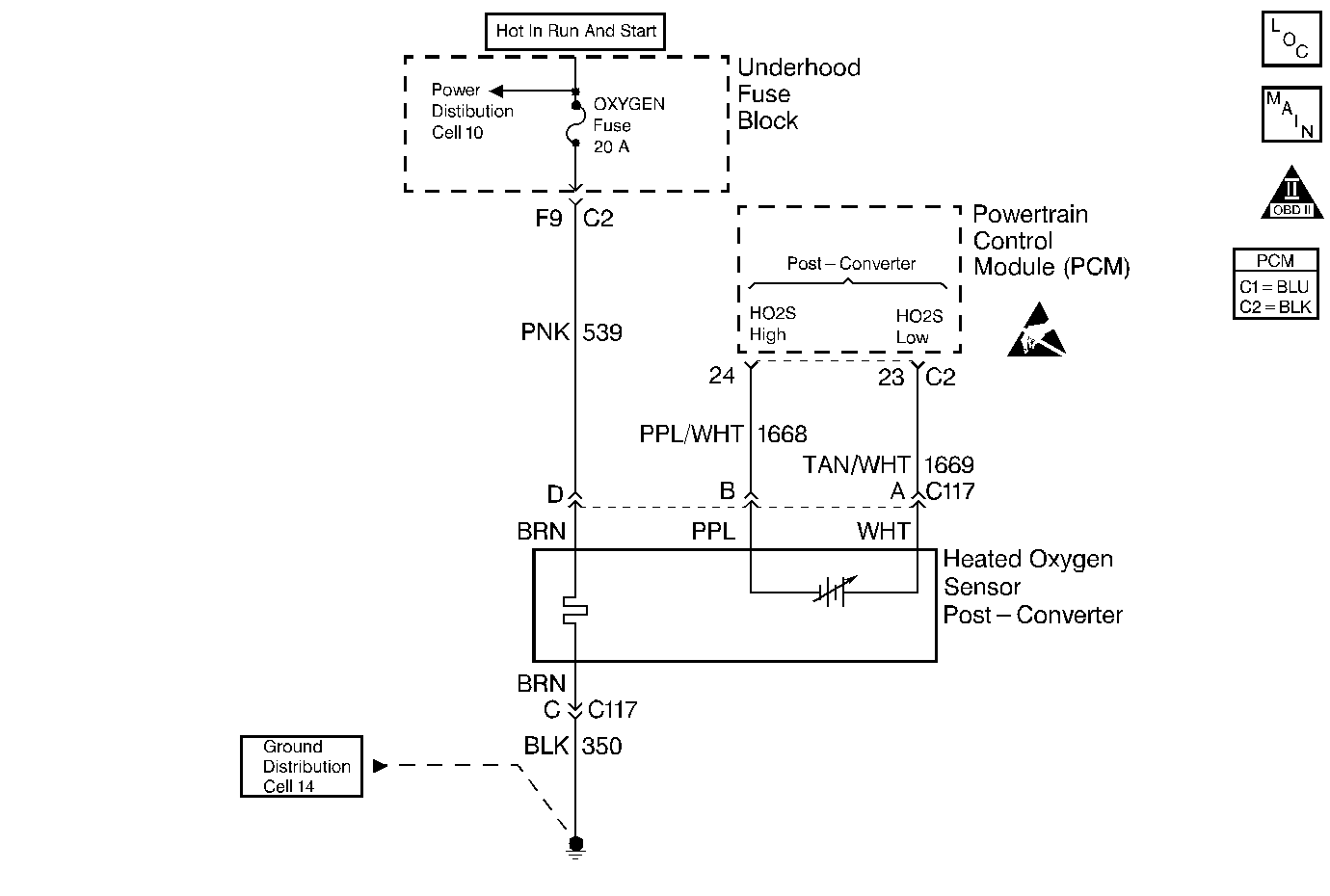
Circuit Description
The PCM has the ability to monitor this process by using a rear Heated Oxygen Sensor (HO2S 2). The rear HO2S 2, located in the exhaust stream past the catalytic converter, produces an output signal relative to the oxygen storage capacity of the catalytic converter. The PCM then calculates the ability of the catalytic converter to convert the exhaust emissions effectively. Whenever the catalytic converter is functioning properly, the rear HO2S 2 signal will be far less active than the signal produced by the front Oxygen Sensor 1(O2S 1).
Conditions for Setting the DTC
| • | DTCs P0106, P0107, P0108, P0112, P0113, P0117, P0118, P0121, P0122, P0123, P0171, P0200, P0300, P0301, P0302, P0303, P0304, P0341, P0404, P0506, P0507, P0601, P0602 not set. |
| • | Air flow is greater than 5.5 grams per second. |
| • | Engine Coolant Temperature (ECT) is greater than 40°C (104°F). |
| • | Throttle Position (TP) angle is between 5% and 50% for 4 seconds. |
| • | HO2S 2 voltage is greater than 1042 mV for 50 to 75 seconds. |
Action Taken When the DTC Sets
| • | The malfunction indicator lamp (MIL) will illuminate after two consecutive ignition cycles in which the diagnostic runs with the malfunction present. |
| • | The PCM will record the operating conditions at the time that the diagnostic fails. This information will store in the Freeze Frame and Failure Records buffers. |
| • | A history DTC stores. |
Conditions for Clearing the MIL/DTC
| • | The malfunction indicator lamp (MIL) will turn OFF after 3 consecutive ignition cycles in which the diagnostic runs without a fault. |
| • | A history DTC will clear after 40 consecutive warm up cycles without a fault. |
| • | Use a scan tool to clear the DTCs. |
Diagnostic Aids
Whenever the oxygen sensor pigtail wiring, connector or terminal are damaged, the entire oxygen sensor assembly must be replaced. Do not attempt to repair the wiring, connector or terminals. In order for the sensor to function properly, the O2S must have a clean air reference. This clean air reference is obtained by way of the oxygen sensor wires. Any attempt to repair the wires, connectors or terminals could result in the obstruction of the air reference and degrade the performance of the oxygen sensor.
Check for the following conditions:
| • | A rich exhaust - An overly rich exhaust may load the catalytic converter causing high rear HO2S 2 signal voltages. |
| • | A silicone contamination - A silicone contamination of the rear HO2S 2 may cause a false rich condition. A powdery white deposit on the rear HO2S 2 will indicate this condition. |
| • | A faulty HO2S 2 - Whenever the rear HO2S 2 is internally shorted, the rear HO2S 2 voltage displayed on a scan tool will be over 1.0 volt. Disconnect the rear HO2S 2 . Jumper the rear HO2S low circuit to the engine ground. Whenever the rear HO2S 2 voltage goes from 100 mV to around 450 mV, replace the rear HO2S 2. |
| • | An intermittent test - Observe the rear HO2S 2 on a scan tool while moving the related connectors and wiring harness with the key ON. Whenever the fault is induced, the rear HO2S 2 display will change. This may help isolate the location of the malfunction. |
| • | A damaged harness - Inspect the PCM harness for a short to voltage in the rear HO2S 2 low circuit. |
Test Description
Number(s) below refer to the step number(s) on the Diagnostic Table.
-
The Powertrain OBD System Check prompts the technician to complete some basic checks and store the freeze frame and failure records data on the scan tool if applicable. This creates an electronic copy of the data taken when the malfunction occurred. The information is then stored on the scan tool for later reference.
-
This step determines if DTC P0138 is the result of a hard malfunction or an intermittent condition.
-
Disconnecting HO2S 2 and jumpering both the HO2S 2 signal circuit and HO2S 2 ground circuit to ground should cause the scan tool to display HO2S 2 voltage below 100 mV (0.1V). If the signal voltage is still high, the PCM is malfunctioning.
-
Replacement PCMs must be reprogrammed and the crankshaft position system variation procedure must be performed. Refer to the latest Techline information for PCM reprogramming and also refer to the for the Crankshaft Position System Variation Procedure.
Step | Action | Value(s) | Yes | No |
|---|---|---|---|---|
Was the Powertrain On-Board Diagnostic (OBD) System Check performed? | -- | |||
Is the HO2S 2 sensor voltage above the specified value? | 1042 mV (1.042V) | |||
3 |
Is the HO2S 2 sensor voltage above the specified value? | 1042 mV (1.042V) | ||
4 |
Does the DMM indicate a voltage of the specified value? | 0.0V - 0.5V | ||
Does the scan tool indicate the HO2S 2 sensor voltage below the specified value? | 100 mV (0.10V) | |||
6 | Repair the short to voltage in the HO2S 2 sensor high circuit. Is the action complete? | -- | -- | |
7 | Replace the HO2S 2 sensor. Refer to Heated Oxygen Sensor Replacement . Is the action complete? | -- | -- | |
Replace the PCM. Refer to Powertrain Control Module Replacement . Is the action complete? | -- | -- | ||
9 |
Does the scan tool indicate that this diagnostic ran and passed? | -- | ||
10 | Check if any additional DTCs are set. Are any DTCs displayed that have not been diagnosed? | -- | Go to the Applicable DTC table | System OK |
